2023 Annual Report for: Coleophoridae / Coleophorinae
For species seen in 2023 that had less than or equal to 100 records, full details are included; for more common species, the earliest, latest and highest count by vice-county are shown. The narrative for each species is taken from the main Hantsmoths website, and it is possible that some information on abundance and occurrence can get out of date, as it is impossible to keep up with all changes; however it should give a good introduction to each species. The tables in each species account summarise the previous status, and that for the current year.
For the maps, all records prior to 2023 are shown by a blue dot (the larger the dot, the more recent), with the current year's records shown in red. As previous records are superimposed on any report for 2023, new sites have greater emphasis (i.e. will show as 'more red').
In the species accounts, an asterisk next to a location indicates a new 10km square record; earliest ever dates are highlighted in orange, and latest ever in red. Initials in the species accounts refer to the recorders listed here. Please get in touch if you identify any omissions or errors, in particular if you have records that have yet to be submitted. Details of how to submit records can be found here.
37.002 [B&F: 0487] Coleophora lutarea (Haworth, 1828) - Local
Local in open woodland in southern England and south Wales. Reported from scattered locations in Hampshire, and only common in recent years from Pamber Forest: the Isle of Wight saw no records between the first in 1929, and 2012, when larvae were found in some numbers at Godshill. One was also seen in Firestone Copse in 2014. It is probably overlooked, and it may be found in new areas by searching for the adult moth which often rests on the flowers of the foodplant in sunshine, feeding on the nectar. The larva feeds within seeds of Greater Stitchwort, living within a movable case. Adult wingspan 9-11 mm.
Records prior to 2023
| Vice County | #Records | #Individuals | First Record | Last Record |
|---|---|---|---|---|
| 10 | 3 | 1 | 1929 | 2014 |
| 11 | 29 | 51 | 1975 | 2020 |
| 12 | 45 | 163 | 1991 | 2022 |
2023 records
| Vice County | #Records | #Individuals | Max Quantity |
|---|---|---|---|
| 11 | 2 | 4 | 3 |
| 12 | 5 | 7 | 3 |

Records by year
Records by week (adult)
Records by week (larval)
Record Details
VC11: Otterbourne, three, field observation, on Stellaria holostea flowers, 03 May (JOug); Botley Wood, one, on host-plant, adult on Greater Stitchwort. Comm. by email 3.vii.2023. , 21 May (DPH);
VC12: Stockbridge Down*, present, 02 Jun (MEdg); Odiham Common, one, field observation, 26 May (AMD); one, field observation, 29 May (MJW); three, field observation, 27 May (BGD); Rye Common, two, field observation, 02 May (AMD)
37.005 [B&F: 0490] Coleophora lutipennella (Zeller, 1838) - Common
Common in oak woodland, woodland rides and areas with scattered trees throughout much of England, Wales and southern Scotland. In Hampshire and on the Isle of Wight common and widespread. Wingspan 10-12 mm. Imago very similar to C. flavipennella. Like many of the Coleophora, imagines are virtually impossible to identify without recourse to dissection, and the larvae, which live in cases of characteristic form and which can sometimes be found on the foodplant, may be easier to identify by comparison against a reference collection. Larva mines leaves of Oak, living within a movable case, which differs from that of C. flavipennella in having leaf material at the back end of the case.
Records prior to 2023
| Vice County | #Records | #Individuals | First Record | Last Record |
|---|---|---|---|---|
| 10 | 6 | 9 | 2007 | 2021 |
| 11 | 214 | 280 | 1969 | 2022 |
| 12 | 46 | 42 | 1994 | 2022 |
2023 records
| Vice County | #Records | #Individuals | Max Quantity |
|---|---|---|---|
| 11 | 3 | 3 | 1 |
| 12 | 2 | 3 | 2 |
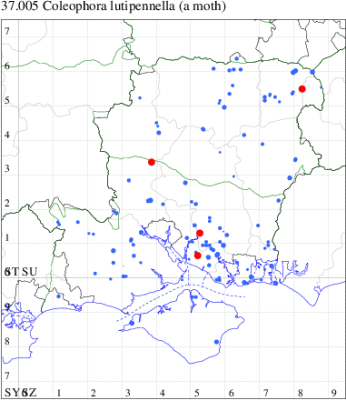
Records by year
Records by week (adult)
Records by week (larval)
Record Details
VC11: Winter Down Copse, Little Somborne, one, 31 Jul (GCE); Titchfield Common, one, male gen det. , 12 Jul (DWal det. RJD); Curdridge, one, gen det. , 08 Jul (JCol);
VC12: Fleet Pond, one, field observation, 13 Jul; two, 13 Jul (MHals)
37.007 [B&F: 0492] Coleophora flavipennella (Duponchel, [1843]) - Common
Common in oak woodland, woodland rides and areas with scattered trees throughout much of England and Wales; rare in Ireland and Scotland. In Hampshire and on the Isle of Wight common and widespread. Wingspan 10.5-12.5 mm. Imago very similar to C. lutipennella. Like many of the Coleophora, imagines are virtually impossible to identify without recourse to dissection, and the larvae, which live in cases of characteristic form and which can sometimes be found on the foodplant, may be easier to identify by comparison against a reference collection. Larva mines leaves of Oak, living within a movable case, , which differs from that of C. lutipennella in having no leaf material at the back end of the case.
Records prior to 2023
| Vice County | #Records | #Individuals | First Record | Last Record |
|---|---|---|---|---|
| 10 | 14 | 2 | 1999 | 2014 |
| 11 | 209 | 231 | 1973 | 2022 |
| 12 | 41 | 41 | 1971 | 2022 |
2023 records
| Vice County | #Records | #Individuals | Max Quantity |
|---|---|---|---|
| 11 | 2 | 2 | 1 |
| 12 | 1 | 2 | 2 |
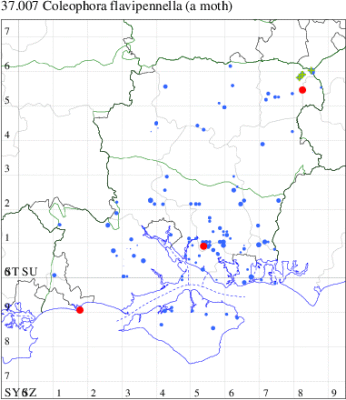
Records by year
Records by week (adult)
Records by week (larval)
Record Details
VC11: Botley Wood, one, gen. det., 04 Aug (AMD); Hengistbury Head*, one, 27 Jun (MJef det. AMD);
VC12: Fleet Pond, two, 27 Jun (MHals)
37.009 [B&F: 0496] Coleophora milvipennis Zeller, 1839 - Local
Local on heathland and in open woodland throughout much of Britain; rare in Ireland. Probably under-recorded in Hampshire and on the Isle of Wight, where the extent of known records correlate with those areas in which the recording effort is concentrated. Wingspan 10.5-13 mm. Like many of the Coleophora, imagines are virtually impossible to identify without recourse to dissection, and the larvae, which live in cases of characteristic form and which can sometimes be found on the foodplant, may be easier to identify by comparison against a reference collection. Larva mines leaves of Birch, living within a movable case.
Records prior to 2023
| Vice County | #Records | #Individuals | First Record | Last Record |
|---|---|---|---|---|
| 10 | 1 | 1 | 1977 | 1977 |
| 11 | 85 | 79 | 1979 | 2022 |
| 12 | 9 | 11 | 1980 | 2022 |
2023 records
| Vice County | #Records | #Individuals | Max Quantity |
|---|---|---|---|
| 11 | 3 | 3 | 1 |
| 12 | 1 | 1 | 1 |
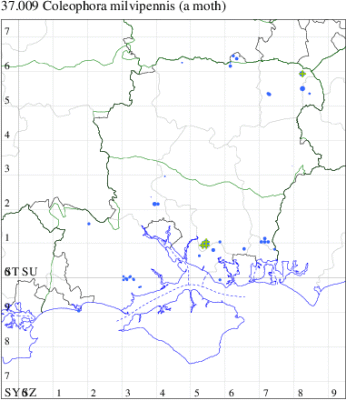
Records by year
Records by week (adult)
Records by week (larval)
Record Details
VC11: Botley Wood, case, one, on host-plant, on birch along the substation road. Comm. by email 3.vii.2023. , 10 Jun; case, one, field observation, on birch, 10 Jun; case, one, on host-plant, 10 Jun (DPH);
VC12: Yateley Common, case, one, field observation, 19 Mar (BGD)
37.010 [B&F: 0498] Coleophora alnifoliae Barasch, 1934 - Nationally Scarce B
Nationally scarce (Nb) in woodland and freshwater margins in small, isolated colonies in south-eastern and central southern England, as far north as Shropshire; Perthshire (MBGBI Vol 3). In Hampshire apparently restricted to Pamber Common Hook Common and Fleet in the north, and Hookheath Meadows NR in the south. Not recorded from the Isle of Wight to date. Wingspan 12-13 mm. Like many of the Coleophora, imagines are virtually impossible to identify without recourse to dissection, and the larvae, which live in cases of characteristic form and which can sometimes be found on the foodplant, may be easier to identify by comparison against a reference collection. Larva mines leaves of Alder, living within a movable case, over-wintering twice in some areas.
Records prior to 2023
| Vice County | #Records | #Individuals | First Record | Last Record |
|---|---|---|---|---|
| 11 | 10 | 33 | 1999 | 2005 |
| 12 | 5 | 6 | 2003 | 2008 |
2023 records
| Vice County | #Records | #Individuals | Max Quantity |
|---|---|---|---|
| 11 | 1 | 1 | 1 |
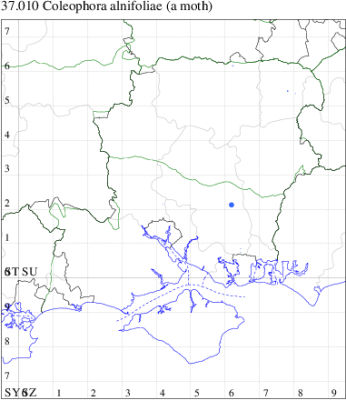
Records by year
Records by week (adult)
Records by week (larval)
Record Details
VC11: Exton*, case, one, field observation, on Alder, 14 Oct (AMD)
37.011 [B&F: 0497] Coleophora badiipennella (Duponchel, [1843]) - Local
Local in hedgerows, woodland margins and scrubland throughout much of England. In Hampshire largely restricted to the south-east of the county and known from the Isle of Wight only from the north-west. Wingspan 9-11 mm. Differs from C. adjectella in having dark-tipped scales over much of the forewing; C. trigeminella has dark-tipped scales nearly confined to wing-apex (MBGBI Vol 3). Larva mines leaves of English and Small-leaved Elm, preferring young trees, and living within a movable case; case length 5-6 mm.
Records prior to 2023
| Vice County | #Records | #Individuals | First Record | Last Record |
|---|---|---|---|---|
| 10 | 8 | 3 | 1997 | 2007 |
| 11 | 80 | 118 | 1974 | 2021 |
| 12 | 8 | 6 | 1996 | 2022 |
2023 records
| Vice County | #Records | #Individuals | Max Quantity |
|---|---|---|---|
| 11 | 1 | 2 | 2 |
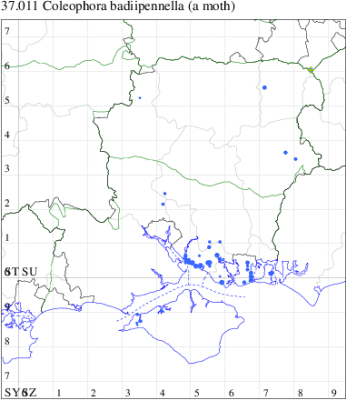
Records by year
Records by week (adult)
Records by week (larval)
Record Details
VC11: Stokes Bay*, case, two, field observation, 24 Sep (DPH)
37.015 [B&F: 0493] Coleophora serratella (Linnaeus, 1761) - Common
Common in woodland, hedgerows, heathland and fens throughout much of the British Isles, except for the Outer Hebrides, Orkney and Shetland. In Hampshire and on the Isle of Wight common and widespread. Wingspan 10.5-14 mm. Like many of the Coleophora, imagines are virtually impossible to identify without recourse to dissection, and the larvae, which live in cases of characteristic form and which can sometimes be found on the foodplant, may be easier to identify by comparison against a reference collection. Larva mines leaves of Birch, Alder, Elm and Hazel, living within a movable case.
Records prior to 2023
| Vice County | #Records | #Individuals | First Record | Last Record |
|---|---|---|---|---|
| 10 | 99 | 59 | 1900 | 2022 |
| 11 | 442 | 352 | 1972 | 2022 |
| 12 | 127 | 161 | 1974 | 2022 |
2023 records
| Vice County | #Records | #Individuals | Max Quantity |
|---|---|---|---|
| 11 | 3 | 3 | 1 |
| 12 | 3 | 35 | 26 |

Records by year
Records by week (adult)
Records by week (larval)
Record Details
VC11: Holmhill Inclosure, NF, case, one, field observation, on Betula, 14 May (AMD); Romsey, one, gen det. , 16 Jul (NRJ det. DJG); Hengistbury Head, larva, one, field observation, 10 May (BGD);
VC12: Harewood Forest, larva, eight, field observation, 07 May; Minley Wood, larva, 26, field observation, 03 May; Yateley Common, larva, one, field observation, 07 May (BGD)
37.022 [B&F: 0504] Coleophora lusciniaepennella (Treitschke, 1833) - Common
Common in freshwater margins, woodland, bogs and fens throughout much of the British Isles, except for the extreme north of Scotland and the Orkney and Shetland Islands. In Hampshire and on the Isle of Wight common and widespread, especially in the south of the county. Wingspan 10-13.5 mm. Like many of the Coleophora, imagines are virtually impossible to identify without recourse to dissection, and the larvae, which live in cases of characteristic form and which can sometimes be found on the foodplant, may be easier to identify by comparison against a reference collection. Larva mines leaves of Sallow, Willow, Osier, Bog-myrtle and Birch, living within a movable case.
Records prior to 2023
| Vice County | #Records | #Individuals | First Record | Last Record |
|---|---|---|---|---|
| 10 | 19 | 18 | 1902 | 2021 |
| 11 | 147 | 107 | 1973 | 2022 |
| 12 | 16 | 9 | 1988 | 2011 |
2023 records
| Vice County | #Records | #Individuals | Max Quantity |
|---|---|---|---|
| 11 | 3 | 5 | 3 |
| 12 | 1 | 1 | 1 |
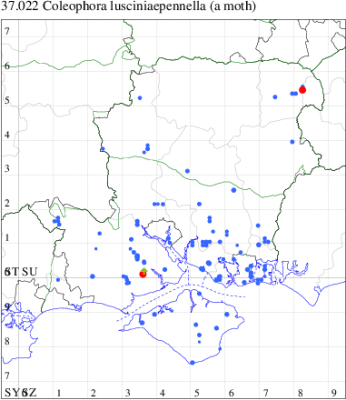
Records by year
Records by week (adult)
Records by week (larval)
Record Details
VC11: Shatterford, NF, case, three, field observation, (2 larvae seen). , 11 Nov (DPH); Hatchet Pond, NF, one, field observation, gen det. , 17 Jun (STho); Stubbington, case, one, field observation, old case on Sallow. , 03 Dec (DPH);
VC12: Fleet Pond, one, 27 Jun (MHals)
37.026 [B&F: 0509] Coleophora violacea (Ström, 1783) - Nationally Scarce B
Nationally scarce (Nb) in open woodland, parks and scrubland throughout much of Britain, except for the far north of Scotland and the Hebrides, Orkney and Shetland. In Hampshire apparently rather scarce, typical finds being of single cases or single moths at light; an empty case was found on the Isle of Wight in 1995. Like many of the Coleophora, imagines are virtually impossible to identify without recourse to dissection, and the fact that the larva of this species is highly polyphagous means that cases are difficult to find. Wingspan 9-11 mm. Larva mines leaves of deciduous trees and shrubs, living within a movable case. The case is very similar to that of C. potentillae.
Records prior to 2023
| Vice County | #Records | #Individuals | First Record | Last Record |
|---|---|---|---|---|
| 10 | 1 | 1 | 1995 | 1995 |
| 11 | 13 | 13 | 1979 | 2012 |
| 12 | 6 | 6 | 1994 | 2022 |
2023 records
| Vice County | #Records | #Individuals | Max Quantity |
|---|---|---|---|
| 11 | 6 | 6 | 2 |
| 12 | 1 | 1 | 1 |
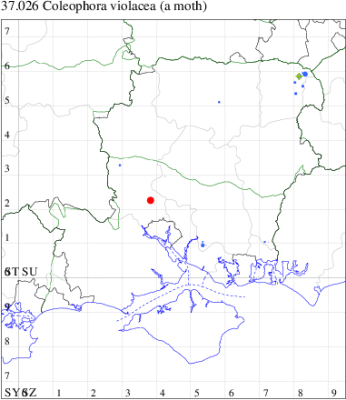
Records by year
Records by week (adult)
Records by week (larval)
Record Details
VC11: Romsey, one, to pheromone lure, to NI lure - gen det. , 26 May; one, to pheromone lure, cUL lure. , 27 May; one, 28 May; two, to pheromone lure, to NI lure at 14.00. , 30 May; present, to pheromone lure, to CUL lure at 14.00. , 01 Jun (NRJ);
VC12: Yateley Common, larva, one, field observation, 13 Apr (BGD)
37.027 [B&F: 0513] Coleophora potentillae Elisha, 1885 - Local
Local in rough grassland, damp woodland, fens, ditches and woodland rides in England, south of a line from Lincolnshire to Herefordshire, central and western Scotland, and western Ireland. In Hampshire and on the Isle of Wight there are scattered records throughout, but most frequent at Leckford, Botley Wood, Teg Down and Emer Bog. Wingspan 8-9.5 mm. Like many of the Coleophora, imagines are virtually impossible to identify without recourse to dissection, and best identified in the field, where in Hampshire the larvae are mainly found on rosaceous herbs and shrubs. Foodplants are wide ranging, quoted as including Agrimonia (Agrimony), Filpendula ulmaria (Meadowsweet), Fragaria vesca (Wild Strawberry), Geum spp (Avens), Potentilla spp. (Cinquefoils), Rosa spp. (Rose), Rubus sp (brambles). and also Crataegus (Hawthorn), Betula (Birch), Prunus spinosa (Blackthorn) and Helianthemum (Rock Rose). The case resembles that of C.violacea, but does not lie so flat again the leaf as this species (having a mouth angle of 30 to 50°). C.violacea also has a case which bulges in the middle, whereas in C.potentillae the case tapers towards the posterior.
Records prior to 2023
| Vice County | #Records | #Individuals | First Record | Last Record |
|---|---|---|---|---|
| 10 | 7 | 3 | 1938 | 2003 |
| 11 | 35 | 21 | 1978 | 2019 |
| 12 | 8 | 7 | 1987 | 2020 |
2023 records
| Vice County | #Records | #Individuals | Max Quantity |
|---|---|---|---|
| 11 | 2 | 0 | 0 |
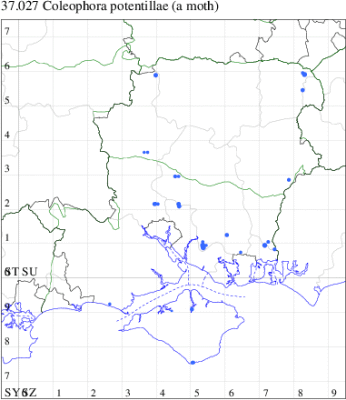
Records by year
Records by week (adult)
Records by week (larval)
Record Details
VC11: Botley Wood, larval feeding signs, present, on host-plant, mines on bramble, without a case. , 02 Feb (DWal det. DPH); Whiteley, larval feeding signs, present, field observation, on Bramble. , 02 Feb (DPH)
37.028 [B&F: 0510] Coleophora juncicolella Stainton, 1851 - Local
Local on heathland and moorland throughout much of Britain, as far north as west Ross; rare in Ireland. In Hampshire virtually restricted to heaths in the New Forest and the north-east of the county. First recorded on the Isle of Wight in 2015, with another in 2022, both at Headon Warren on the western tip of the island. Wingspan 6-8 mm. Candidates for this taxon may be picked out as it is significantly smaller than other Coleophora, but specimens are required for accurate determination. Larva mines leaves of Heather and Bell Heather, living within a movable case.
Records prior to 2023
| Vice County | #Records | #Individuals | First Record | Last Record |
|---|---|---|---|---|
| 10 | 2 | 14 | 2015 | 2022 |
| 11 | 30 | 55 | 1975 | 2015 |
| 12 | 6 | 8 | 1998 | 2007 |
2023 records
| Vice County | #Records | #Individuals | Max Quantity |
|---|---|---|---|
| 12 | 1 | 1 | 1 |
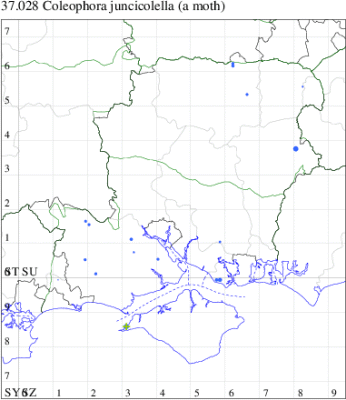
Records by year
Records by week (adult)
Records by week (larval)
Record Details
VC12: Broxhead Common*, case, one, swept, 26 Apr (AMD)
37.031 [B&F: 0514] Coleophora ahenella Heinemann, [1876] - Nationally Scarce A
Nationally scarce (Na) on chalk downland and heathland in south-central England, where restricted to Hampshire and adjoining counties. In Hampshire recorded from the New Forest, where cases are found on trunks of Alder Buckthorn, and on the chalk, where found in small numbers in scrub containing Buckthorn. Not recorded from the Isle of Wight to date. Wingspan 10-13 mm. The main confusion species is C. potentillae but usually slightly larger and with small differences in the coloration of the inner side of the labial palpus and the hindleg (MBGBI Vol 3). Larva mines leaves of Buckthorn or Alder Buckthorn, living within a movable case; case length 5.5-7 mm.
Records prior to 2023
| Vice County | #Records | #Individuals | First Record | Last Record |
|---|---|---|---|---|
| 11 | 9 | 6 | 1982 | 2020 |
| 12 | 11 | 13 | 1979 | 2020 |
2023 records
| Vice County | #Records | #Individuals | Max Quantity |
|---|---|---|---|
| 12 | 1 | 1 | 1 |
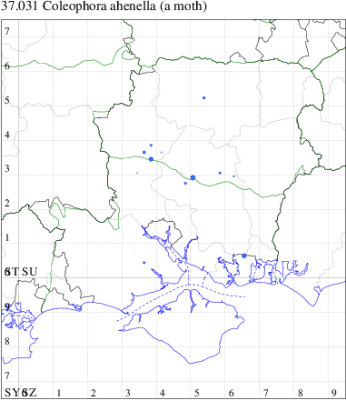
Records by year
Records by week (adult)
Records by week (larval)
Record Details
VC12: Magdalen Hill Down NR*, case, one, field observation, case and mines on Rhamnus., 05 Oct (GTor)
37.032 [B&F: 0515] Coleophora albitarsella Zeller, 1849 - Local
Local in hedgerows, open woodland, fens and downland throughout much of England and Wales, more numerous in the south. In Hampshire and on the Isle of Wight there are scattered records throughout, with no apparent population centre. Wingspan 10-13 mm. The pale tarsi that gives the species its scientific name are a ready means of recognition. Larva mines leaves of Wild Basil, Wild Marjoram, Self-heal, Ground-ivy and Mint, living within a movable case; case length 9 mm.
Records prior to 2023
| Vice County | #Records | #Individuals | First Record | Last Record |
|---|---|---|---|---|
| 10 | 39 | 20 | 1902 | 2022 |
| 11 | 85 | 89 | 1978 | 2022 |
| 12 | 68 | 74 | 1985 | 2022 |
2023 records
| Vice County | #Records | #Individuals | Max Quantity |
|---|---|---|---|
| 11 | 5 | 5 | 1 |
| 12 | 3 | 3 | 1 |

Records by year
Records by week (adult)
Records by week (larval)
Record Details
VC11: Fareham, case, one, on host-plant, case with feeding larva on Bowles' Mint, Mentha x villosa var alopecuroides., 30 Apr (RJD); Botley, one, 15 Jun (SLB); Horndean, case, one, field observation, 18 Jun; one, 18 Jul (PHog);
VC12: Overton, one, 19 Jul (ACr); Basingstoke, one, 27 Jun; one, 27 Jul (MJW)
37.033 [B&F: 0516] Coleophora trifolii (Curtis, 1832) - Local
Local on rough grassland, waste ground and roadside verges throughout much of the British Isles, less numerous in Scotland, more numerous in the south. In Hampshire widely but thinly distributed, records increasing in recent years; on the Island still rarely reported. Wingspan 15-20 mm. The comparatively large size, metallic green forewings with copper apex and white tip to antennae, make this species one of the few which can be identified without recourse to dissection of the genitalia, although the differences in size between this and other related species may only be obvious in series of mounted, set specimens. Larva feeds within seedpods of Ribbed Melilot and Tall Melilot, living within a movable case.
Records prior to 2023
| Vice County | #Records | #Individuals | First Record | Last Record |
|---|---|---|---|---|
| 10 | 60 | 75 | 1856 | 2022 |
| 11 | 253 | 335 | 1972 | 2022 |
| 12 | 131 | 172 | 1993 | 2022 |
2023 records
| Vice County | #Records | #Individuals | Max Quantity |
|---|---|---|---|
| 11 | 11 | 11 | 1 |
| 12 | 3 | 5 | 3 |
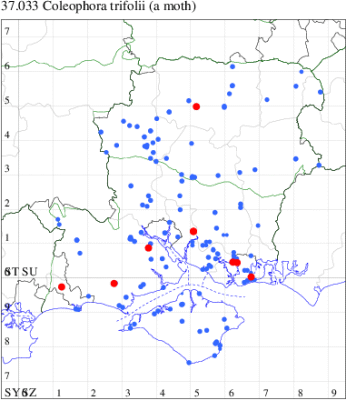
Records by year
Records by week (adult)
Records by week (larval)
Record Details
VC11: Marchwood, one, 24 Jul (TDCh); Botley, one, 18 Jul; one, 25 Jul; one, 27 Jul (SLB); Portchester, one, 13 Jul (DH-J); Horsea Island, one, 16 Jun (F.M.G.); Portsmouth, one, 13 Jun; one, 21 Jun; one, 24 Jun (IRT); Hurn, one, 15 Jun (MJef); Sway, one, 21 Jun (SKee);
VC12: Overton, one, 10 Aug; one, 19 Aug; three, 22 Aug (ACr)
37.035 [B&F: 0517] Clover Case-bearer Coleophora alcyonipennella (Kollar, 1832) - Local
Local on rough grassland and waste ground, although the exact status and distribution of this species is unclear due to past confusion with C. frischella, which is very similar and can only be separated through dissection of the genitalia. In Hampshire widespread and almost certainly under-recorded; this is certainly the case on Wight, where it was determined for the first time at Totland in 2021 and found to be common at the same site in 2022. Wingspan 11.5-14.5 mm. Larva feeds within seedheads of White Clover, living within a movable case.
Records prior to 2023
| Vice County | #Records | #Individuals | First Record | Last Record |
|---|---|---|---|---|
| 10 | 11 | 28 | 2021 | 2022 |
| 11 | 527 | 692 | 1973 | 2022 |
| 12 | 74 | 100 | 1994 | 2022 |
2023 records
| Vice County | #Records | #Individuals | Max Quantity |
|---|---|---|---|
| 11 | 6 | 6 | 1 |
| 12 | 11 | 15 | 2 |

Records by year
Records by week (adult)
Records by week (larval)
Record Details
VC11: Ogden's Purlieu, NF*, one, gen. det., 17 Jun (AMD); Culverley, NF*, one, gen det, 30 May (CLew); Winchester, one, 05 Sep (THW); Fareham, one, 18 Jul (MLO); Portsmouth, one, 19 Jul (IRT); Hengistbury Head, one, 12 Jun (MJef det. AMD);
VC12: Overton, one, 17 Jun (ACr); Basingstoke, two, 09 Jun; two, 10 Jun; one, 24 Jun; Sherborne St John, one, 16 Jun (MJW); Alton, one, 16 Aug (DBO det. MJW); Noar Hill HIWWT NR, Selborne, one, gen. det., 11 Aug (AMD, FHay det. AMD); Blacknest, Binstead*, one, 08 Aug (MAng); Hammer Vale, Woolmer*, two, 27 Jul; two, 06 Sep (ASwa); Yateley Common, one, 26 Aug (BGD)
37.036 [B&F: 0521] Coleophora conyzae Zeller, 1868 - Nationally Scarce B
Nationally scarce (Nb) in chalk downland and freshwater margins in parts of southern England and southern Wales. In Hampshire mainly confined to the south-east, with just a handful of records in the north of the county and on the Isle of Wight. Wingspan 12-16 mm. Like many of the Coleophora, imagines are virtually impossible to identify without recourse to dissection, and the larvae, which live in cases of characteristic form and which can sometimes be found on the foodplant, may be easier to identify by comparison against a reference collection. Larva mines leaves of Ploughman's-spikenard and Common Fleabane, living within a movable case.
Records prior to 2023
| Vice County | #Records | #Individuals | First Record | Last Record |
|---|---|---|---|---|
| 10 | 13 | 11 | 1900 | 2019 |
| 11 | 108 | 116 | 1967 | 2021 |
| 12 | 1 | 1 | 2011 | 2011 |
2023 records
| Vice County | #Records | #Individuals | Max Quantity |
|---|---|---|---|
| 11 | 1 | 2 | 2 |
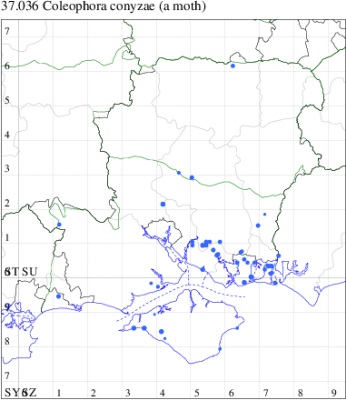
Records by year
Records by week (adult)
Records by week (larval)
Record Details
VC11: Botley Wood, case, two, on host-plant, on fleabane, just W of the substation. Comm. by email 3.vii.2023. , 21 May (DPH)
37.038 [B&F: 0522] Coleophora lineolea (Haworth, 1828) - Local
Local in hedgerows and waste ground throughout much of southern England and Wales, with records north to Yorkshire. In Hampshire the majority of records are from Portsea and Hayling Islands, with scattered records elsewhere across our two counties. Wingspan 11-14.5 mm. Candidates for this species can be picked out by the yellow-ochreous wing veins, but is more easily verified at the larval stage with its distinctive case made of rings of mined leaf, fully developed in May. Larva mines leaves of labiates, in particular Hedge Woundwort and Black Horehound, but also uses White Horehound and Betony.
Records prior to 2023
| Vice County | #Records | #Individuals | First Record | Last Record |
|---|---|---|---|---|
| 10 | 19 | 19 | 1977 | 2022 |
| 11 | 293 | 355 | 1972 | 2022 |
| 12 | 12 | 7 | 1984 | 2020 |
2023 records
| Vice County | #Records | #Individuals | Max Quantity |
|---|---|---|---|
| 11 | 6 | 9 | 5 |
| 12 | 2 | 2 | 1 |
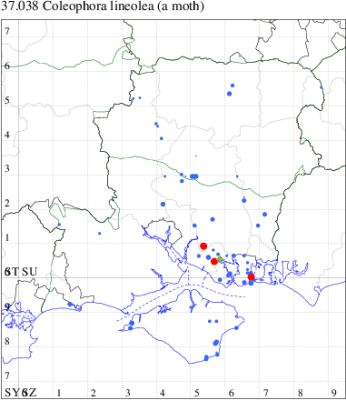
Records by year
Records by week (adult)
Records by week (larval)
Record Details
VC11: Botley Wood, larval feeding signs, present, on host-plant, 10 Jun (DPH); one, gen. det., 04 Aug (AMD); case, one, field observation, on Hedge Woundwort. , 18 Jun (DPH); Fareham, one, 12 Jun (ADT); Portsmouth, one, 20 Aug (IRT); Eastney Beach, Portsmouth, larva, five, field observation, at least 5 on Ballota nigra, 25 Apr (RJD, IRT det. IRT);
VC12: Magdalen Hill Down NR, case, one, field observation, 05 Oct (AMD); case, one, field observation, case and mines on Stachys sylvatica, 05 Oct (GTor)
37.039 [B&F: 0523] Coleophora hemerobiella (Scopoli, 1763) - Local
Local in hedgerows, gardens and orchards throughout much of south-eastern England. First recorded in Hampshire in Shroner Wood, north Hampshire, in 1965, but then not seen again until 2003, when increasingly found in suitable habitat in the north-east of the county. Not recorded from the Isle of Wight to date. Wingspan 12-15 mm. The forewings are pale grey and the stigma is normally clearly visible; the species is usually quite unmistakable. Larva mines leaves of Hawthorn, Apple, Wild Cherry, Rowan, Pear, Plum and Whitebeam, causing sufficient damage to be a serious pest in some areas, living within a movable case, and over-wintering twice; case length 8-11 mm.
Records prior to 2023
| Vice County | #Records | #Individuals | First Record | Last Record |
|---|---|---|---|---|
| 10 | 2 | 2 | 2015 | 2017 |
| 11 | 5 | 5 | 2007 | 2018 |
| 12 | 21 | 47 | 1965 | 2012 |
2023 records
| Vice County | #Records | #Individuals | Max Quantity |
|---|---|---|---|
| 12 | 1 | 3 | 3 |
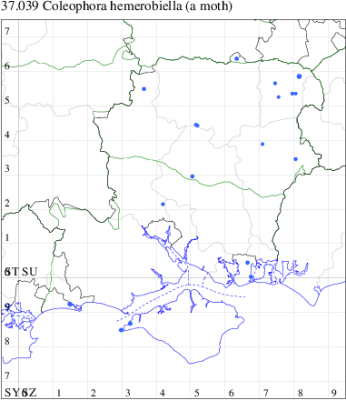
Records by year
Records by week (adult)
Records by week (larval)
Record Details
VC12: Minley Wood, larva, three, field observation, 03 May (BGD)
37.041 [B&F: 0546] Coleophora genistae Stainton, 1857 - Nationally Scarce A
Nationally scarce (Na) in rough grassland, damp heathland, mosses and moorland in England northwards to Loch Ness, Scotland; rare in North Wales (MBGBI Vol 3). In Hampshire virtually restricted to the New Forest and, in the north of the county, Bartley Heath. Not recorded from the Isle of Wight since 1969. Wingspan 11-13 mm. Very similar to C. saturatella. Like many of the Coleophora, imagines are virtually impossible to identify without recourse to dissection, and the larvae, which live in cases of characteristic form and which can sometimes be found on the foodplant, may be easier to identify by comparison against a reference collection. Larva mines leaves of Petty Whin, living within a movable case, often several together.
Records prior to 2023
| Vice County | #Records | #Individuals | First Record | Last Record |
|---|---|---|---|---|
| 10 | 2 | 7 | 1969 | 1969 |
| 11 | 14 | 22 | 1999 | 2022 |
| 12 | 8 | 21 | 1985 | 2007 |
2023 records
| Vice County | #Records | #Individuals | Max Quantity |
|---|---|---|---|
| 11 | 1 | 1 | 1 |

Records by year
Records by week (adult)
Records by week (larval)
Record Details
VC11: Andrew's Mare, NF, case, one, field observation, 14 May (AMD)
37.042 [B&F: 0545] Coleophora saturatella Stainton, 1850 - pRDB3
Rare (proposed as a future Red Data Book species) on heathland, open woodland and rough pastures in parts of south-eastern England. In Hampshire and on the Isle of Wight recorded very occasionally, and reported from Blackbushe Airfield in the north in 2020. Wingspan 12-15 mm. The main confusion species is C. genistae, but that species has the ground colour of the forewing paler and more ochreous and the costal streak reaching almost to the apex (MBGBI Vol 3). Larva mines leaves of Broom and Dyer's Greenweed, living within a movable case; case length 8 mm.
Records prior to 2023
| Vice County | #Records | #Individuals | First Record | Last Record |
|---|---|---|---|---|
| 10 | 3 | 0 | 1900 | 1929 |
| 11 | 5 | 2 | 1990 | 2011 |
| 12 | 4 | 9 | 2020 | 2021 |
2023 records
| Vice County | #Records | #Individuals | Max Quantity |
|---|---|---|---|
| 12 | 1 | 3 | 3 |
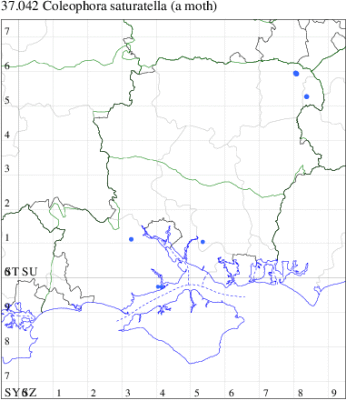
Records by year
Records by week (adult)
Records by week (larval)
Record Details
VC12: Yateley Common, larva, three, field observation, 09 Apr (BGD)
37.044 [B&F: 0547] Coleophora discordella Zeller, 1849 - Common
Common in rough grassland, downland and woodland clearings and in marshes and other damp places throughout much of the British Isles, except the Shetland Islands. In Hampshire and on the Isle of Wight rather infrequently recorded, with the usual concentration of records in the south-east of the county, probably under-recorded elsewhere. Wingspan 11-12.5 mm. Like many of the Coleophora, imagines are virtually impossible to identify without recourse to dissection, and the larvae, which live in cases of characteristic form and which can sometimes be found on the foodplant, may be easier to identify by comparison against a reference collection. Larva mines leaves of Common Bird's-foot Trefoil and Greater Bird's-foot Trefoil, living within a movable case.
Records prior to 2023
| Vice County | #Records | #Individuals | First Record | Last Record |
|---|---|---|---|---|
| 10 | 15 | 7 | 1850 | 2022 |
| 11 | 46 | 45 | 1977 | 2021 |
| 12 | 5 | 4 | 1971 | 2011 |
2023 records
| Vice County | #Records | #Individuals | Max Quantity |
|---|---|---|---|
| 12 | 1 | 30 | 30 |
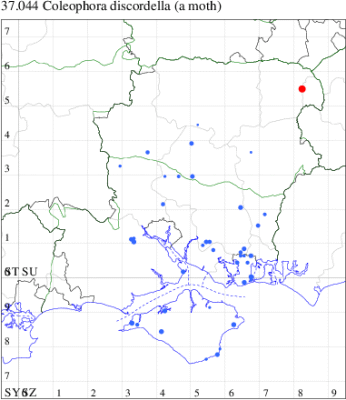
Records by year
Records by week (adult)
Records by week (larval)
Record Details
VC12: Fleet Pond*, 30, field observation, 03 Jun (MHals)
37.046 [B&F: 0519] Coleophora deauratella Lienig & Zeller, 1846 - Local
Local on waste ground, grassland and roadside verges throughout S. England and S. Wales. In Hampshire recorded fairly frequently only in the south-east, but the true distribution poorly known due to confusion with other related species. Not recorded from the Isle of Wight since 1900. Wingspan 10.5-12.5 mm. Day-flying, but comes to light, although less frequently than other related species. Can be separated from C. alcyonipennella and C. frischella only by dissection of the genitalia. Larva feeds within seedheads of Red Clover, living within a movable case; case length 6 mm.
Records prior to 2023
| Vice County | #Records | #Individuals | First Record | Last Record |
|---|---|---|---|---|
| 10 | 11 | 10 | 1900 | 2022 |
| 11 | 149 | 156 | 1972 | 2022 |
| 12 | 25 | 43 | 1986 | 2011 |
2023 records
| Vice County | #Records | #Individuals | Max Quantity |
|---|---|---|---|
| 11 | 1 | 1 | 1 |
| 12 | 2 | 2 | 1 |
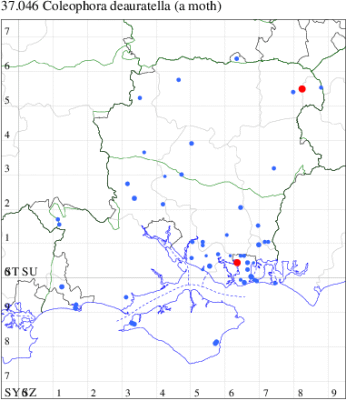
Records by year
Records by week (adult)
Records by week (larval)
Record Details
VC11: Horsea Island, one, male. , 16 Jun (F.M.G. det. RJD);
VC12: Fleet Pond, one, 10 Aug; one, 10 Aug (MHals)
37.048 [B&F: 0518] Coleophora mayrella (Hübner, [1813]) - Common
Common on grassland, roadside verges and waste ground throughout much of the British Isles. In Hampshire reported at light across much of the county, but no recent records from the Isle of Wight. Wingspan 10.5-12 mm. Like many of the Coleophora, imagines are virtually impossible to identify without recourse to dissection, and the larvae, which live in cases of characteristic form and which can sometimes be found on the foodplant, may be easier to identify by comparison against a reference collection. Larva feeds within seedheads of White Clover, living within a movable case, and can be collected and bred through as described in MBGBI Vol 3.
Records prior to 2023
| Vice County | #Records | #Individuals | First Record | Last Record |
|---|---|---|---|---|
| 10 | 11 | 9 | 1930 | 2021 |
| 11 | 155 | 177 | 1973 | 2022 |
| 12 | 83 | 111 | 1990 | 2022 |
2023 records
| Vice County | #Records | #Individuals | Max Quantity |
|---|---|---|---|
| 11 | 2 | 2 | 1 |
| 12 | 2 | 3 | 2 |
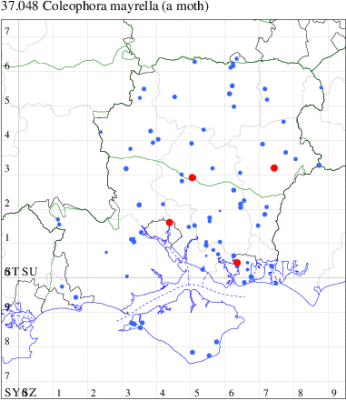
Records by year
Records by week (adult)
Records by week (larval)
Record Details
VC11: Swaythling, Southampton, one, 17 Aug (MEdg); Horsea Island, one, 16 Jun (F.M.G.);
VC12: Magdalen Hill Down NNR, one, 10 Jun (KArb, SIng, PPea); Noar Hill HIWWT NR, Selborne, two, 09 Jun (AMD, FHay det. AMD)
37.049 [B&F: 0533] Pistol Case-bearer Coleophora anatipennella (Hübner, 1796) - Local
Local in scrubland, hedgerows, parks and gardens in southern England and Wales; rare elsewhere. In Hampshire virtually restricted to the south coast in the east of the county, very rare inland or in the west; on the Isle of Wight, the few records have all been on the north coast. Wingspan 12.5-17 mm. Like many of the Coleophora, imagines are virtually impossible to identify without recourse to dissection, and the larvae, which live in cases of characteristic form and which can sometimes be found on the foodplant, may be easier to identify by comparison against a reference collection. Larva mines leaves of Blackthorn, and also Wild Cherry, Hawthorn, Apple, Pear and Rowan, living within a movable pistol-case.
Records prior to 2023
| Vice County | #Records | #Individuals | First Record | Last Record |
|---|---|---|---|---|
| 10 | 15 | 10 | 1998 | 2021 |
| 11 | 104 | 107 | 1975 | 2021 |
| 12 | 14 | 18 | 1994 | 2011 |
2023 records
| Vice County | #Records | #Individuals | Max Quantity |
|---|---|---|---|
| 12 | 1 | 0 | 0 |
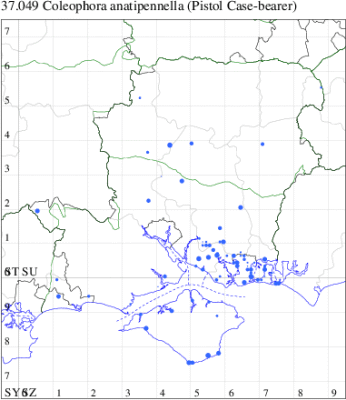
Records by year
Records by week (adult)
Records by week (larval)
Record Details
VC12: South Wonston*, case, present, field observation, prunus spinosa, 13 Sep (JOug)
37.050 [B&F: 0532] Coleophora albidella ([Denis & Schiffermüller], 1775) - Local
Local in fens, bogs, damp woodland, marshes, river-banks and damp areas throughout much of England and Wales, most frequently in the west; rare in Ireland. In Hampshire and on the Isle of Wight, it appears be nowhere frequent even in appropriate habitat, with the cases hard to find and most records relate to adults at light that have been critically examined. The larva feeds within buds of Grey Willow, Eared Willow and Creeping Willow, preferring young trees, living within a distinctive curled case.
Records prior to 2023
| Vice County | #Records | #Individuals | First Record | Last Record |
|---|---|---|---|---|
| 10 | 4 | 4 | 2006 | 2020 |
| 11 | 31 | 34 | 1984 | 2021 |
| 12 | 9 | 17 | 1999 | 2014 |
2023 records
| Vice County | #Records | #Individuals | Max Quantity |
|---|---|---|---|
| 11 | 3 | 3 | 1 |
| 12 | 1 | 1 | 1 |
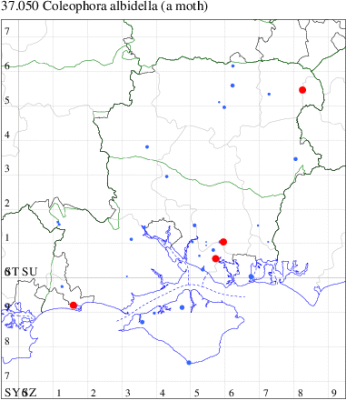
Records by year
Records by week (adult)
Records by week (larval)
Record Details
VC11: Fareham, one, 21 Aug (IMcP); Wickham, one, male gen det. , 23 Jun (F.M.G. det. RJD); Hengistbury Head, one, 12 Jun (MJef det. AMD);
VC12: Fleet Pond*, one, 27 Jun (MHals)
37.051 [B&F: 0537] Coleophora kuehnella (Goeze, 1783) - Local
Local in oak woodland and oak scrub throughout England. Sparsely recorded in Hampshire, and more frequent in the southern half. Not recorded from the Isle of Wight since 1900. Wingspan 14-17 mm. As an adult, the main confusion species are C. betulella, in which the costal cilia are not tipped white, and C. ibipennella, which shares the white-tipped cilia of C. kuehnella, but which is normally smaller and has the base of the cilia blackish rather than grey (MBGBI Vol 3). Larva mines leaves of Oak, living within a distinctive case with a characteristic 'bubble' appearance; case length 8 mm.
Records prior to 2023
| Vice County | #Records | #Individuals | First Record | Last Record |
|---|---|---|---|---|
| 10 | 4 | 2 | 1900 | 2016 |
| 11 | 52 | 61 | 1977 | 2022 |
| 12 | 9 | 5 | 1980 | 2010 |
2023 records
| Vice County | #Records | #Individuals | Max Quantity |
|---|---|---|---|
| 11 | 2 | 2 | 1 |
| 12 | 1 | 1 | 1 |
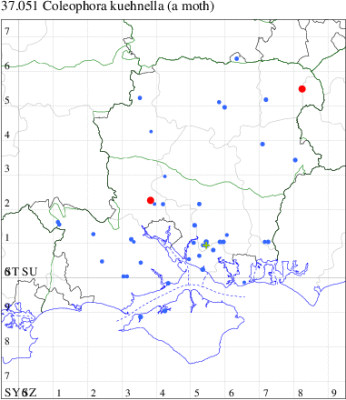
Records by year
Records by week (adult)
Records by week (larval)
Record Details
VC11: Romsey, one, gen det. , 12 Jun (NRJ det. DJG); Botley Wood, case, one, field observation, case. , 19 Aug (DPH);
VC12: Fleet Pond*, one, 10 Jun (MHals)
37.052 [B&F: 0535] Coleophora ibipennella Zeller, 1849 - Local
Local in oak woodland in the south-east of England, extending in decreasing numbers northwards and westwards to Lincolnshire, Herefordshire and Cornwall (MBGBI Vol 3). In Hampshire and on the Isle of Wight widely distributed and fairly common throughout. Wingspan 10-14 mm. Thoroughly confused with C. betulella in the past. Like many of the Coleophora, imagines are virtually impossible to identify without recourse to dissection, and the larvae, which live in cases of characteristic form and which can sometimes be found on the foodplant, may be easier to identify by comparison against a reference collection. Larva mines leaves of Oak, subsequently living within a movable pistol-case.
Records prior to 2023
| Vice County | #Records | #Individuals | First Record | Last Record |
|---|---|---|---|---|
| 10 | 6 | 2 | 1977 | 2020 |
| 11 | 52 | 43 | 1977 | 2021 |
| 12 | 27 | 27 | 1993 | 2020 |
2023 records
| Vice County | #Records | #Individuals | Max Quantity |
|---|---|---|---|
| 11 | 2 | 2 | 1 |
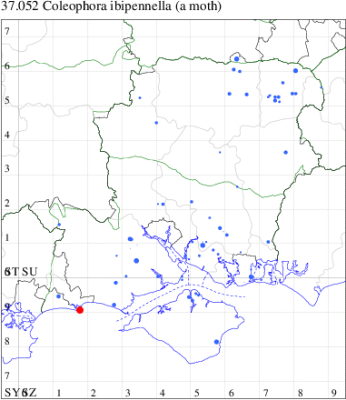
Records by year
Records by week (adult)
Records by week (larval)
Record Details
VC11: Woodfidley Passage, NF, case, one, field observation, 11 Nov (DPH); Hengistbury Head, one, 27 Jun (MJef det. AMD)
37.055 [B&F: 0541] Coleophora pyrrhulipennella Zeller, 1839 - Local
Local on heathland, moorland and bogs throughout much of Britain, north to the Great Glen. In Hampshire there are recent records from the New Forest, Wickham Common Pamber Forest and the north-eastern heaths, elsewhere there are scattered records from south-east Hampshire and the Isle of Wight. Wingspan 11-14.5 mm. One of the more distinctive Coleophora. Larva feeds on leaves of Heather and Bell Heather, living within a movable case; case length 9 mm.
Records prior to 2023
| Vice County | #Records | #Individuals | First Record | Last Record |
|---|---|---|---|---|
| 10 | 4 | 11 | 1969 | 2015 |
| 11 | 39 | 55 | 1978 | 2014 |
| 12 | 18 | 14 | 1980 | 2022 |
2023 records
| Vice County | #Records | #Individuals | Max Quantity |
|---|---|---|---|
| 11 | 1 | 1 | 1 |
| 12 | 3 | 6 | 4 |
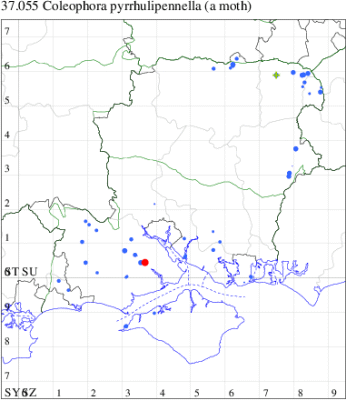
Records by year
Records by week (adult)
Records by week (larval)
Record Details
VC11: Culverley, NF, one, gen det, 30 May (CLew);
VC12: Broxhead Common, case, one, swept, 26 Apr (AMD); Yateley Common, larva, one, field observation, 25 Mar; larva, four, field observation, 04 Apr (BGD)
37.059 [B&F: 0538] Coleophora vibicella (Hübner, [1813]) - pRDB2
Vulnerable (proposed as a future Red Data Book species) in rough pastures and woodland rides, declining, and now probably restricted to Hampshire and adjoining counties, a priority species under the UK Biodiversity Action Plan. In Hampshire recorded recently from Beaulieu, Hayling Island, Stubbington and, most notably, Botley Wood; on the Isle of Wight recorded recently only from Newtown NR. Wingspan 17-22 mm. Almost always recorded in the larval stage, when the cases are fairly easy to find where they are present; the adult can only be separated from similar Coleophora by dissection of the genitalia. Larva mines leaves of Dyer's Greenweed, living within a movable case; case length 19 mm.
Records prior to 2023
| Vice County | #Records | #Individuals | First Record | Last Record |
|---|---|---|---|---|
| 10 | 87 | 2749 | 1900 | 2022 |
| 11 | 67 | 2944 | 1900 | 2022 |
2023 records
| Vice County | #Records | #Individuals | Max Quantity |
|---|---|---|---|
| 11 | 2 | 1050 | 1049 |
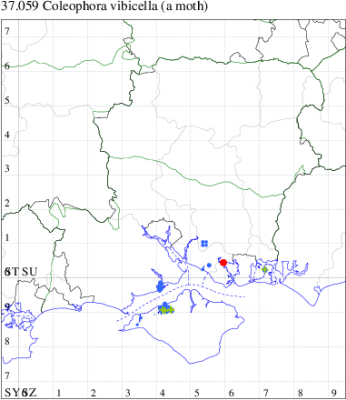
Records by year
Records by week (adult)
Records by week (larval)
Record Details
VC10: Newtown Meadows, case, 44, field observation, 25 Jul (AMD);
VC11: DM Gosport, Bedenham, one, field observation, 17 Aug; Hayling Billy, case, 1049, field observation, 1 hour timed count, 12 Jul (AMD)
37.063 [B&F: 0544] Coleophora albicosta (Haworth, 1828) - Common
Common in rough grassland, downland and heathland throughout much of the British Isles. In Hampshire common in the south, and on the heaths in the north-east of the county, with scattered records elsewhere; no recent records from the Isle of Wight. Wingspan 12-15.5 mm. Imago is one of the more easily recognisable species, and well-marked specimens may safely be identified without recourse to dissection. Larva feeds within seedpods of Gorse, living within a movable case.
Records prior to 2023
| Vice County | #Records | #Individuals | First Record | Last Record |
|---|---|---|---|---|
| 10 | 8 | 4 | 1937 | 2020 |
| 11 | 210 | 333 | 1971 | 2022 |
| 12 | 61 | 110 | 1971 | 2022 |
2023 records
| Vice County | #Records | #Individuals | Max Quantity |
|---|---|---|---|
| 11 | 7 | 9 | 2 |
| 12 | 3 | 3 | 1 |
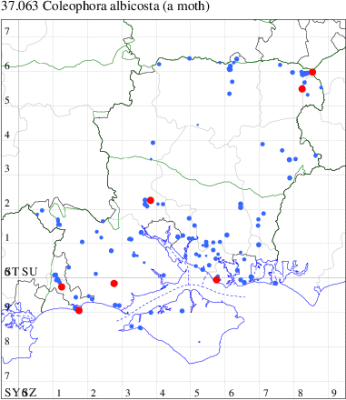
Records by year
Records by week (adult)
Records by week (larval)
Record Details
VC11: Romsey, one, photos available. , 21 May; one, 28 May (NRJ); Hurn, one, 28 May; Hengistbury Head, two, 23 May (MJef); Sway, two, 24 May (SKee); Browndown Coastal Ranges, one, 05 May (F.M.G. det. RJD); Browndown, one, field observation, 07 May (IHrg det. MJW);
VC12: Fleet Pond, one, netted, 05 May; one, 14 May (MHals); Blackwater, one, 11 Jun (BGD)
37.066 [B&F: 0526] Larch Case-bearer Coleophora laricella (Hübner, [1817]) - Common
Common in woodland throughout much of the British Isles, except for the extreme north of Scotland, the Outer Hebrides, Orkney and Shetland (MBGBI Vol 3). In Hampshire and on the Isle of Wight recorded widely, but thinly, with the usual cluster of records in the south-east of the county, and probably under-recorded elsewhere. Wingspan 8-11 mm. Like many of the Coleophora, imagines are virtually impossible to identify without recourse to dissection, and the larvae, which live in cases of characteristic form and which can sometimes be found on the foodplant, may be easier to identify by comparison against a reference collection. Larva mines leaves of European Larch, living within a movable case, causing sufficient damage to be a serious pest in some areas.
Records prior to 2023
| Vice County | #Records | #Individuals | First Record | Last Record |
|---|---|---|---|---|
| 10 | 1 | 0 | 1983 | 1983 |
| 11 | 47 | 50 | 1981 | 2022 |
| 12 | 14 | 24 | 2004 | 2011 |
2023 records
| Vice County | #Records | #Individuals | Max Quantity |
|---|---|---|---|
| 11 | 1 | 1 | 1 |
| 12 | 2 | 7 | 6 |
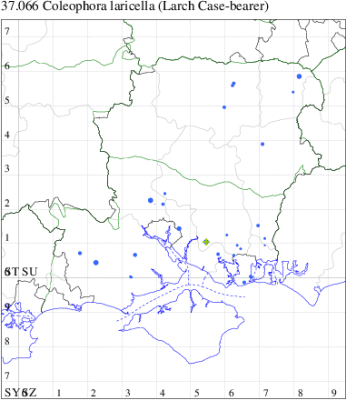
Records by year
Records by week (adult)
Records by week (larval)
Record Details
VC11: Botley Wood, case, one, field observation, case. , 08 Apr (DPH);
VC12: Minley Wood*, larva, six, field observation, 22 Apr; larva, one, field observation, 03 May (BGD)
37.069 [B&F: 0587] Coleophora caespititiella Zeller, 1839 - Common
Common in woodland clearings, damp meadows and marshes, both salt and fresh-water, throughout much of England, Wales and southern Ireland. In Hampshire widespread; the paucity of records from the Isle of Wight no doubt reflects historical under-recording, as evidenced by an increase in known range in recent years. Wingspan 8-10 mm. Like many of the Coleophora, imagines are virtually impossible to identify without recourse to dissection. Larva feeds within seed capsules of Compact Rush, Soft-rush, Jointed Rush, Hard Rush and Saltmarsh Rush, subsequently living within a movable case.
Records prior to 2023
| Vice County | #Records | #Individuals | First Record | Last Record |
|---|---|---|---|---|
| 10 | 6 | 4 | 1850 | 2022 |
| 11 | 479 | 1490 | 1972 | 2022 |
| 12 | 45 | 58 | 1995 | 2022 |
2023 records
| Vice County | #Records | #Individuals | Max Quantity |
|---|---|---|---|
| 11 | 5 | 7 | 2 |
| 12 | 2 | 2 | 1 |
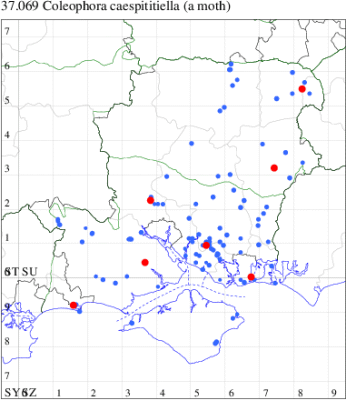
Records by year
Records by week (adult)
Records by week (larval)
Record Details
VC11: Culverley, NF, two, gen det, 30 May (CLew); Romsey, two, gen det. , 28 May (NRJ det. DJG); Botley Wood, one, male gen det. , 09 Jun (F.M.G.); Portsmouth, one, 24 May (IRT); Hengistbury Head, one, 12 Jun (MJef det. AMD);
VC12: Noar Hill HIWWT NR, Selborne, one, gen. det., 09 Jun (AMD, FHay det. AMD); Fleet Pond, one, field observation, 03 Jun (MHals)
37.070 [B&F: 0583] Coleophora tamesis Waters, 1929 - Local
Local in damp meadows, bogs and woodland rides throughout much of the British Isles. In Hampshire very infrequent on the south coast, from Southsea in the east to Keyhaven in the west, with a few old records from the north of the county. First recorded on the Isle of Wight in 2021. Wingspan 11-14 mm. Like many of the Coleophora, imagines are virtually impossible to identify without recourse to dissection, and best identified from the larval cases, found on the seeds of Jointed Rush.
Records prior to 2023
| Vice County | #Records | #Individuals | First Record | Last Record |
|---|---|---|---|---|
| 10 | 2 | 2 | 2021 | 2022 |
| 11 | 10 | 10 | 1985 | 2017 |
| 12 | 3 | 4 | 1967 | 1984 |
2023 records
| Vice County | #Records | #Individuals | Max Quantity |
|---|---|---|---|
| 11 | 1 | 2 | 2 |

Records by year
Records by week (adult)
Records by week (larval)
Record Details
VC11: Hengistbury Head, two, 12 Jun (MJef det. AMD)
37.071 [B&F: 0582] Coleophora glaucicolella Wood, 1892 - Common
Common in marshes, fens, damp meadows, woodland rides and saltmarshes throughout much of the British Isles. In Hampshire and on the Isle of Wight occurs principally in the south of the county and the north of the Island, with isolated records in the north of the county, at Sherborne St John, Fleet Pond, Eelmoor Marsh and Winnall Moor. Wingspan 10-12 mm. Very similar to C. alticolella. Like many of the Coleophora, imagines are virtually impossible to identify without recourse to dissection, and the larvae, which live in cases of characteristic form and which can sometimes be found on the foodplant, may be easier to identify by comparison against a reference collection. Larva feeds on seeds of Compact Rush, Soft-rush, Hard Rush and Saltmarsh Rush, living within a movable case.
Records prior to 2023
| Vice County | #Records | #Individuals | First Record | Last Record |
|---|---|---|---|---|
| 10 | 26 | 18 | 1850 | 2022 |
| 11 | 233 | 305 | 1973 | 2019 |
| 12 | 11 | 6 | 1987 | 2022 |
2023 records
| Vice County | #Records | #Individuals | Max Quantity |
|---|---|---|---|
| 11 | 3 | 7 | 5 |
| 12 | 1 | 0 | 0 |
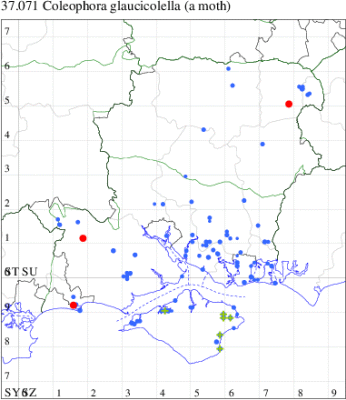
Records by year
Records by week (adult)
Records by week (larval)
Record Details
VC11: Ogden's Purlieu, NF, one, gen. det., 17 Jun (AMD); Hengistbury Head, one, 12 Jun (MJef det. AMD); larva, five, field observation, larva examined, 10 May (BGD);
VC12: Rye Common*, present, netted, abundant, 1m gen. det., 06 Jun (AMD)
37.072 [B&F: 0578] Coleophora otidipennella (Hübner, [1817]) - Common
Local in grassland, downland, heathland and woodland rides throughout much of the British Isles. In Hampshire recorded from Pamber Heath and Botley Wood, with scattered records elsewhere in the county; there have been a few records from the Isle of Wight. Wingspan 10-13 mm. Like many of the Coleophora, imagines are virtually impossible to identify without recourse to dissection, and the larvae, which live in cases of characteristic form and which can sometimes be found on the foodplant, may be easier to identify by comparison against a reference collection. Larva feeds on seeds of Field Wood-rush and Heath Wood-rush, living within a movable case.
Records prior to 2023
| Vice County | #Records | #Individuals | First Record | Last Record |
|---|---|---|---|---|
| 10 | 1 | 1 | 1967 | 1967 |
| 11 | 41 | 58 | 1974 | 2014 |
| 12 | 11 | 24 | 1976 | 2021 |
2023 records
| Vice County | #Records | #Individuals | Max Quantity |
|---|---|---|---|
| 12 | 6 | 27 | 18 |

Records by year
Records by week (adult)
Records by week (larval)
Record Details
VC12: Minley Wood, 18, field observation, gen det. , 29 Apr; one, field observation, gen det. , 04 May; one, field observation, gen det. , 29 May (BGD); Ancells Farm HWT reserve, one, netted, 30 Apr; Fleet Pond, five, netted, 05 May; one, 14 May (MHals)
37.073 [B&F: 0584] Coleophora alticolella Zeller, 1849 - Common
Common on heathland, damp meadows, marshes and a wide range of other habitats throughout much of the British Isles. Probably the most ubiquitous species of Coleophora occurring in the British Isles, having been recorded from almost every county and often in great abundance (MBGBI Vol 3). In Hampshire and on the Isle of Wight widespread and common, most frequent in the south-east. Wingspan 10-12 mm. Very similar to C. glaucicolella. Like many of the Coleophora, imagines are virtually impossible to identify without recourse to dissection, and the larvae, which live in cases of characteristic form and which can sometimes be found on the foodplant, may be easier to identify by comparison against a reference collection. Larva feeds on seeds of Soft-rush and Heath Rush, living within a movable case.
Records prior to 2023
| Vice County | #Records | #Individuals | First Record | Last Record |
|---|---|---|---|---|
| 10 | 40 | 19 | 1926 | 2021 |
| 11 | 360 | 667 | 1971 | 2022 |
| 12 | 43 | 36 | 1992 | 2022 |
2023 records
| Vice County | #Records | #Individuals | Max Quantity |
|---|---|---|---|
| 11 | 3 | 4 | 2 |
| 12 | 3 | 4 | 2 |
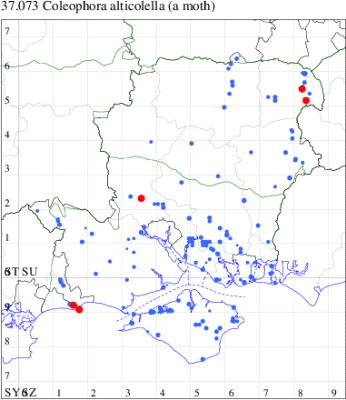
Records by year
Records by week (adult)
Records by week (larval)
Record Details
VC11: Fishlake Meadows, one, gen det, 15 Jun (NRJ det. DJG); Hengistbury Head, two, 12 Jun; one, 23 Jul (MJef det. AMD);
VC12: Fleet Pond, two, field observation, 03 Jun; one, 10 Jun (MHals); Long Valley, Fleet, one, netted, gen. det., 11 Jun (AMD)
37.074 [B&F: 0581] Coleophora taeniipennella Herrich-Schäffer, 1855 - Common
Common in fens, damp meadows and marshes throughout much of the British Isles. In Hampshire almost certainly under-recorded within other Juncus-feeding species, but recorded from areas such the New Forest, Botley Wood and Pamber Forest; recent work has found it to be relatively frequent in the west of the Isle of Wight. Wingspan 9-12 mm. Like many of the Coleophora, imagines are virtually impossible to identify without recourse to dissection, and best recorded by searching for the larvae, which live in cases of characteristic form on seeds of Jointed Rush and Sharp-flowered Rush.
Records prior to 2023
| Vice County | #Records | #Individuals | First Record | Last Record |
|---|---|---|---|---|
| 10 | 4 | 4 | 1978 | 2022 |
| 11 | 75 | 50 | 1973 | 2020 |
| 12 | 9 | 39 | 1975 | 2022 |
2023 records
| Vice County | #Records | #Individuals | Max Quantity |
|---|---|---|---|
| 12 | 2 | 2 | 1 |
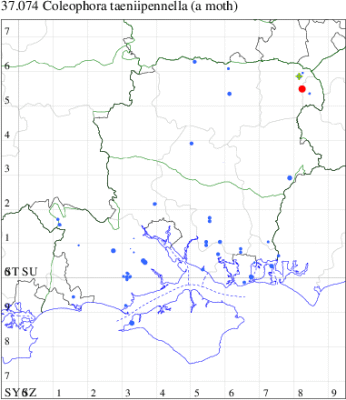
Records by year
Records by week (adult)
Records by week (larval)
Record Details
VC12: Fleet Pond, one, 10 Jun; one, 13 Jul (MHals)
37.075 [B&F: 0575] Coleophora salinella Stainton, 1859 - Nationally Scarce A
Nationally scarce (Na) in saltmarshes throughout much of England. In Hampshire and on the Isle of Wight recorded only from the saltmarshes in the south-east of the county and on the Island. Wingspan 8.5-13 mm. Like many of the Coleophora, imagines are virtually impossible to identify without recourse to dissection, and the larvae, which live in cases of characteristic form and which can sometimes be found on the foodplant, may be easier to identify by comparison against a reference collection. Larva feeds on seeds of Sea-purslane, Grass-leaved Orache and Spear-leaved Orache, living within a movable case.
Records prior to 2023
| Vice County | #Records | #Individuals | First Record | Last Record |
|---|---|---|---|---|
| 10 | 6 | 0 | 1890 | 2006 |
| 11 | 74 | 119 | 1974 | 2022 |
2023 records
| Vice County | #Records | #Individuals | Max Quantity |
|---|---|---|---|
| 11 | 2 | 3 | 2 |
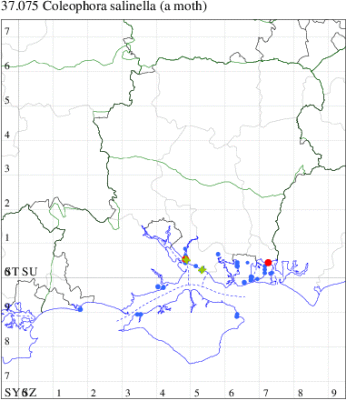
Records by year
Records by week (adult)
Records by week (larval)
Record Details
VC11: Hook with Warsash, two, netted, gen. det., 31 Jul; Northney, one, field observation, gen. det., 12 Aug (AMD)
37.077 [B&F: 0552] Coleophora lassella Staudinger, 1859 - Nationally Scarce B
Nationally scarce (Nb) in bare muddy places and sand-dunes in the south-western counties of England and Ireland, and the Channel Island. In Hampshire mainly restricted to the south-east corner of the county, with a few records from bogs in the New Forest; on the Isle of Wight, recorded at Yarmouth in 1992, but not subsequently. Wingspan 10-12 mm. Like many of the Coleophora, imagines are virtually impossible to identify without recourse to dissection, and the larvae, which live in cases of characteristic form and which can sometimes be found on the foodplant, may be easier to identify by comparison against a reference collection. Larva feeds within seed capsules of Toad Rush, living within a movable case.
Records prior to 2023
| Vice County | #Records | #Individuals | First Record | Last Record |
|---|---|---|---|---|
| 10 | 15 | 21 | 1992 | 2022 |
| 11 | 57 | 61 | 1968 | 2022 |
2023 records
| Vice County | #Records | #Individuals | Max Quantity |
|---|---|---|---|
| 11 | 1 | 1 | 1 |

Records by year
Records by week (adult)
Records by week (larval)
Record Details
VC11: Hengistbury Head*, one, 23 May (MJef det. AMD)
37.078 [B&F: 0585] Coleophora maritimella Newman, 1873 - Nationally Scarce B
Nationally scarce (Nb) on saltmarshes along the coast of England and Wales. In Hampshire and on the Isle of Wight exclusively confined to the coast, where declining, and now largely restricted to the south-east of the county. Wingspan 9-11 mm. Like many of the Coleophora, imagines are virtually impossible to identify without recourse to dissection, and the larvae, which live in cases of characteristic form and which can sometimes be found on the foodplant, may be easier to identify by comparison against a reference collection. Larva feeds within seedheads of Sea Rush, living within a movable case.
Records prior to 2023
| Vice County | #Records | #Individuals | First Record | Last Record |
|---|---|---|---|---|
| 10 | 2 | 0 | 1870 | 2005 |
| 11 | 45 | 56 | 1950 | 2016 |
2023 records
| Vice County | #Records | #Individuals | Max Quantity |
|---|---|---|---|
| 11 | 1 | 1 | 1 |
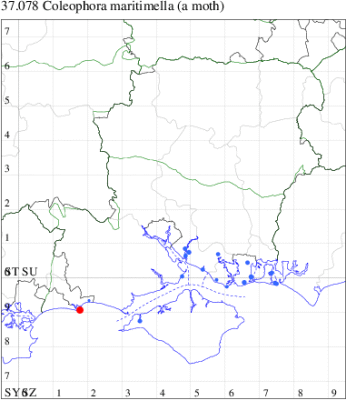
Records by year
Records by week (adult)
Records by week (larval)
Record Details
VC11: Hengistbury Head*, one, 27 Jun (MJef det. AMD)
37.082 [B&F: 0562] Coleophora asteris Mühlig, 1864 - Nationally Scarce A
Nationally scarce (Na) in saltmarshes along the southern and eastern coasts of England, from Devon to south-east Yorkshire, largely absent from the west coast. In Hampshire and on the Isle of Wight occurs on the saltmarshes around the three harbours in the south-east of the county and on the north-west coast of the Island. Wingspan 10-15 mm. Like many of the Coleophora, imagines are virtually impossible to identify without recourse to dissection, and the larvae, which live in cases of characteristic form and which can sometimes be found on the foodplant, may be easier to identify by comparison against a reference collection. Larva feeds on seeds of Sea Aster, living within a movable case. The case is similar to that of C. virgaureae.
Records prior to 2023
| Vice County | #Records | #Individuals | First Record | Last Record |
|---|---|---|---|---|
| 10 | 5 | 43 | 1938 | 2006 |
| 11 | 28 | 28 | 1984 | 2016 |
2023 records
| Vice County | #Records | #Individuals | Max Quantity |
|---|---|---|---|
| 11 | 1 | 4 | 4 |
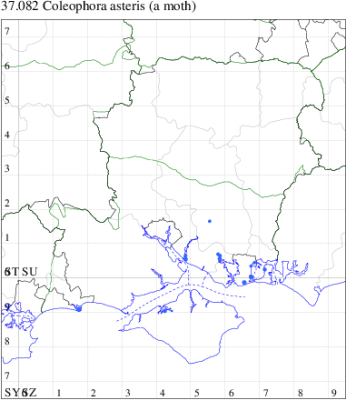
Records by year
Records by week (adult)
Records by week (larval)
Record Details
VC11: Hengistbury Head*, case, four, field observation, in Sea Aster seedheads. , 28 Sep (MJef)
37.095 [B&F: 0556] Coleophora trochilella (Duponchel, [1843]) - Nationally Scarce B
Nationally scarce (Nb) on downland, open scrubland and grassy slopes across southern England and Wales, north to Yorkshire. In Hampshire recorded predominantly from the south-east, where the majority of records are from Southsea, Portsmouth and Botley Wood, elsewhere individuals have been recorded at Leckford, Eelmoor Marsh SSSI and Barton-on-Sea. Not recorded from the Isle of Wight since 1969. Wingspan 11-14 mm. The main confusion species is C. follicularis, from which it is separable only by dissection of the genitalia. Larva mines leaves of Mugwort, Ox-eye Daisy, Tansy, Wormwood and Yarrow, living within a movable case; case length 10 mm.
Records prior to 2023
| Vice County | #Records | #Individuals | First Record | Last Record |
|---|---|---|---|---|
| 10 | 9 | 29 | 1918 | 2021 |
| 11 | 44 | 57 | 1976 | 2014 |
| 12 | 3 | 4 | 1985 | 1998 |
2023 records
| Vice County | #Records | #Individuals | Max Quantity |
|---|---|---|---|
| 11 | 1 | 1 | 1 |

Records by year
Records by week (adult)
Records by week (larval)
Record Details
VC11: Titchfield Common, one, male gen det. , 12 Jul (DWal det. RJD)
37.099 [B&F: 0553] Coleophora striatipennella Nylander [1848] - Common
Common in rough grassland, waste ground, woodland rides, damp woodland, marshes, river-banks and other damp areas throughout much of the British Isles. In Hampshire fairly well-distributed, with the usual concentration of records in the south-east, probably under-recorded elsewhere. First recorded on the Isle of Wight at Brighstone Down in 2009. Wingspan 11-13 mm. Like many of the Coleophora, imagines are virtually impossible to identify without recourse to dissection, and the larvae, which live in cases of characteristic form and which can sometimes be found on the foodplant, may be easier to identify by comparison against a reference collection. Larva feeds within seed capsules of Lesser Stitchwort, Common Chickweed, Common Mouse-ear and Water Chickweed, living within a movable case.
Records prior to 2023
| Vice County | #Records | #Individuals | First Record | Last Record |
|---|---|---|---|---|
| 10 | 5 | 4 | 2009 | 2022 |
| 11 | 122 | 133 | 1972 | 2022 |
| 12 | 29 | 33 | 1981 | 2022 |
2023 records
| Vice County | #Records | #Individuals | Max Quantity |
|---|---|---|---|
| 11 | 1 | 1 | 1 |
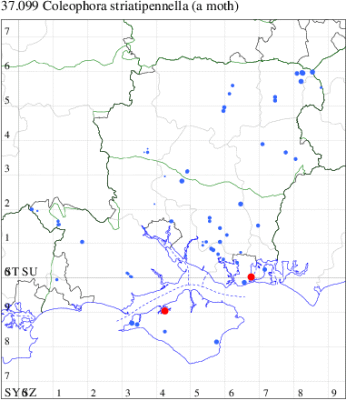
Records by year
Records by week (adult)
Records by week (larval)
Record Details
VC10: Newtown Meadows*, one, field observation, gen. det., 25 Jul (AMD);
VC11: Portsmouth, one, genitalia checked., 18 Jul (IRT)
37.100 [B&F: 0525] Coleophora solitariella Zeller, 1849 - Nationally Scarce B
Nationally scarce (Nb) in hedgerows and open woodland in southern England, as far north as Lincolnshire, and eastern Wales (MBGBI Vol 3). In Hampshire and on the Isle of Wight recorded only a handful of times, mainly in the south of the county, with a single record from the Island. Wingspan 10-12 mm. Like many of the Coleophora, imagines are virtually impossible to identify without recourse to dissection, and the larvae, which live in cases of characteristic form and which can sometimes be found on the foodplant, may be easier to identify by comparison against a reference collection. Larva mines leaves of Greater Stitchwort, living within a movable case.
Records prior to 2023
| Vice County | #Records | #Individuals | First Record | Last Record |
|---|---|---|---|---|
| 10 | 2 | 0 | 1977 | 2012 |
| 11 | 19 | 195 | 1960 | 2022 |
| 12 | 5 | 6 | 1900 | 2022 |
2023 records
| Vice County | #Records | #Individuals | Max Quantity |
|---|---|---|---|
| 12 | 1 | 3 | 3 |
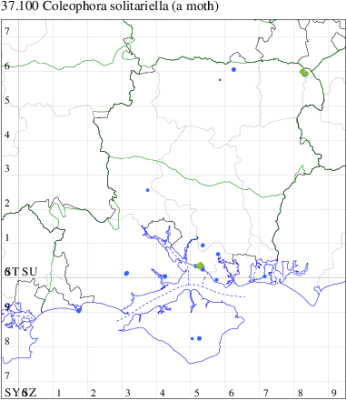
Records by year
Records by week (adult)
Records by week (larval)
Record Details
VC12: Yateley Common, larva, three, field observation, 07 Apr (BGD)
37.102 [B&F: 0563] Coleophora argentula (Stephens, 1834) - Common
Common on waste ground and rough grassland, and by ditches and freshwater margins, throughout much of southern England, Wales and central Scotland. In south Hampshire, cases are common to abundant on yarrow, especially near the coast, but recorded less frequently in the north and on the Isle of Wight. Wingspan 9.5-13 mm. More frequently recorded in the larval stage, when the cases are fairly easy to find where they are present; the imago can be separated from several very similar Coleophora species only by dissection of the genitalia. Larva feeds on flowers and seedheads of Yarrow and Sneezewort, living within a movable case; case length 5-6 mm.
Records prior to 2023
| Vice County | #Records | #Individuals | First Record | Last Record |
|---|---|---|---|---|
| 10 | 28 | 22 | 1850 | 2022 |
| 11 | 167 | 131 | 1975 | 2022 |
| 12 | 47 | 41 | 1985 | 2022 |
2023 records
| Vice County | #Records | #Individuals | Max Quantity |
|---|---|---|---|
| 11 | 3 | 2 | 1 |
| 12 | 1 | 1 | 1 |
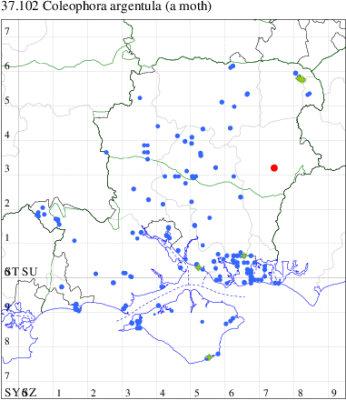
Records by year
Records by week (adult)
Records by week (larval)
Record Details
VC11: Portswood, mine, present, achillea, 09 Nov (JOug); Chilling, case, one, field observation, 22 Oct (DPH); Sandy Point NR, Hayling Island*, case, one, field observation, 03 Oct (AMD);
VC12: Noar Hill HIWWT NR, Selborne*, one, gen. det., 11 Aug (AMD, FHay det. AMD)
37.103 [B&F: 0555] Coleophora follicularis (Vallot, 1802) - Local
Local in damp meadows, marshes, river-banks and woodland rides throughout much of Britain, but not in northern Scotland; occurs also in the southern half of Ireland and in the Channel Islands. In southern Hampshire, widespread and common in the east, notably in and around Botley Wood, and also recorded from the Beaulieu Estate and Needs Ore; very rare in the north of the county, where the only recent records are from Leckford, and on the Isle of Wight. Wingspan 13-15 mm. Very similar to C. trochilella, from which only separated in 1962. Like many of the Coleophora, imagines are virtually impossible to identify without recourse to dissection, and the larvae, which live in cases of characteristic form and which can sometimes be found on the foodplant, may be easier to identify by comparison against a reference collection. Larva mines leaves of Hemp-agrimony, Common Fleabane and Ploughman's-spikenard, living within a movable case.
Records prior to 2023
| Vice County | #Records | #Individuals | First Record | Last Record |
|---|---|---|---|---|
| 10 | 30 | 72 | 1981 | 2022 |
| 11 | 214 | 150 | 1973 | 2022 |
| 12 | 12 | 4 | 1981 | 2010 |
2023 records
| Vice County | #Records | #Individuals | Max Quantity |
|---|---|---|---|
| 11 | 1 | 3 | 3 |
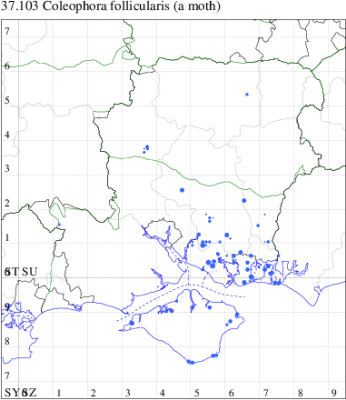
Records by year
Records by week (adult)
Records by week (larval)
Record Details
VC11: Botley Wood, case, three, on host-plant, cases on fleabane. , 27 May (DPH)
37.104 [B&F: 0567] Coleophora adspersella Benander, 1939 - Nationally Scarce B
Nationally scarce (Nb) in saltmarshes, waste ground, farmland and fens throughout much of England and Wales, south of a line from The Wash to the Mersey estuary (MBGBI Vol 3). In Hampshire largely restricted to the south-east coast, with just a few inland records, including one in northern Hampshire, at Greywell in July 2004. Not recorded from the Isle of Wight to date. Wingspan 13-16 mm. Like many of the Coleophora, imagines are virtually impossible to identify without recourse to dissection, and the larvae, which live in cases of characteristic form and which can sometimes be found on the foodplant, may be easier to identify by comparison against a reference collection. Larva feeds on seeds of Grass-leaved Orache and Sea-purslane, living within a movable case.
Records prior to 2023
| Vice County | #Records | #Individuals | First Record | Last Record |
|---|---|---|---|---|
| 10 | 1 | 1 | 1973 | 1973 |
| 11 | 15 | 13 | 1975 | 2022 |
| 12 | 2 | 2 | 2004 | 2010 |
2023 records
| Vice County | #Records | #Individuals | Max Quantity |
|---|---|---|---|
| 11 | 2 | 2 | 1 |

Records by year
Records by week (adult)
Records by week (larval)
Record Details
VC11: Horsea Island, one, 21 Jul; one, female gen.det. , 21 Jul (F.M.G. det. RJD)



